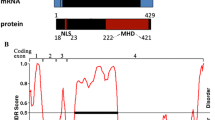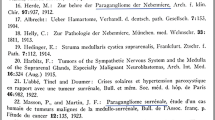Summary
Prostate tumors were induced in Lobund-Wistar rats by treatment with N-methyl-N-nitrosourea (MNU) and testosterone propionate (TP). Androgen receptor (AR) expression was confirmed in 16 (100%) of the primary prostate cancers, with strong uniform staining in well-differentiated tumors and more variable AR immunoreactivity in poorly differentiated tumors. Epithelial cell lines were established from nine of the tumors. At early passages, four of the tumor cell lines tested were strongly immunoreactive for AR; however, only two of the cell lines, E2(A) and F2, have remained AR-positive. These cell lines specifically bind 3H-DHT at 40 and 19 fmol/mg protein, respectively, and express a 110 kDa AR immunoreactive protein. Proliferation in in vitro culture of both E2(A) and F2 cells was increased in the presence of 5α-dihydrotestosterone (DHT). The antiandrogen, hydroxyflutamide was able to prevent the DHT-induced growth of E2(A) but not F2 cells. Furthermore, hydroxyflutamide alone increased proliferation of F2 cells, suggesting that the androgen signalling pathway in this cell line may be abnormal. Tumorigenicity of the AR-expressing and nonexpressing cell lines was confirmed by xenograft formation following subcutaneous inoculation into intact male nude mice. In summary, carcinogen-induced prostate tumors of Lobund-Wistar rats express AR and two of nine cell lines derived from the tumors express AR. Further evaluation of AR structure in primary prostate tumors forming spontaneously or following MNU and TP induction will determine whether, as in human prostate cancers, disease progression in Lobund-Wistar rats is associated with mutations in the AR gene.
Similar content being viewed by others
References
Bentel, J. M.; Tilley, W. D. Androgen receptors in prostate cancer. J. Endocrinol. 151:1–11; 1996.
Bosland, M. C. Chemical and hormonal induction of prostate cancer in animal models. Urol. Oncol. 2:103–110; 1996.
Chang, C. F.; Pollard, M. In vitro propagation of prostate adenocarcinoma cells from rats. Invest. Urol. 14:331–334; 1977.
Chirgwin, J. M.; Przybyla, A. E.; MacDonald, R. J.; Rutter, W. J. Isolation of biologically active ribonucleic acid from sources enriched in ribonuclease. Biochemistry 18:4294–4299; 1979.
Clements, J. A.; Matheson, B. A.; Wines, D. R.; Brady, J. M.; MacDonald, R. J.; Funder, J. W. Androgen dependence of specific kallikrein gene family members expressed in rat prostate. J. Biol. Chem. 263:16132–16137; 1988.
Clements, J. A.; Mukhtar, A.; Holland, A. M.; Ehrlich, A. R.; Fuller, P. J. Kallikrein gene family expression in the rat ovary: localization to the granulosa cell. Endocrinology 136:1137–1144; 1995.
Cohen, M. B.; Heidger, P. M.; Lubaroff, D. M. Gross and microscopic pathology of induced prostatic complex tumors arising in Lobund-Wistar rats. Cancer Res. 54:626–628; 1994.
Culig, Z.; Hobisch, A.; Hittmair, A.; Peterziel, H.; Cato, A. C. B.; Bartsch, G.; Klocker, H. Expression, structure, and function of androgen receptor in advanced prostatic carcinoma. Prostate 35:63–70; 1998.
Danielpour, D.; Kadomatsu, K.; Anzano, M. A.; Smith, J. M.; Sporn, M. B. Development and characterization of nontumorigenic and tumorigenic epithelial cell lines from rat dorsal-lateral prostate. Cancer Res. 54:3413–3421; 1994.
Dong, J.-T.; Lamb, P. W.; Rinker-Schaeffer, C. W.; Vukanovic, J.; Ichikawa, T.; Isaacs, J. T.; Barrett, J. C. KAll, a metastasis suppressor gene for prostatic cancer on human chromosome 11p11.2. Science (Wash DC) 268:884–886; 1995.
Foster, B. A.; Gingrich, J. R.; Kwon, E. D.; Madias, C.; Greenberg, N. M. Characterization of prostatic epithelial cell lines derived from transgenic adenocarcinoma of the mouse prostate (TRAMP) model. Cancer Res. 57:3325–3330; 1997.
Frydenberg, M.; Stricker, P. D.; Kaye, K. W. Prostate cancer diagnosis and management. Lancet 349:1681–1687; 1997.
Greenberg, N. M.; DeMayo, F.; Finegold, M. J.; Medina, D.; Tilley, W. D.; Aspinall, J. O.; Cunha, G. R.; Donjacour, A. A.; Matusik, R. J.; Rosen, J. M. Prostate cancer in a transgenic mouse. Proc. Natl. Acad. Sci. USA 92:3439–3443; 1995.
Hobisch, A.; Culig, Z.; Radmayr, C.; Bartsch, G.; Klocker, H.; Hittmair, A. Distant metastases from prostatic carcinoma express androgen receptor protein. Cancer Res. 55:3068–3072; 1995.
Hoover, D. M.; Best, K. L.; McKenney, B. K.; Tamura, R. N.; Neubauer, B. L. Experimental induction of neoplasia in the accessory sex organs of male Lobund-Wistar rats. Cancer Res. 50:142–146; 1990.
Husmann, D. A.; Wilson, C. M.; McPhaul, M. J.; Tilley, W. D.; Wilson, J. D. Antipeptide antibodies to two distinct regions of the androgen receptor localize the receptor protein to the nuclei of target cells in the rat and human prostate. Endocrinology 126:2359–2368; 1990.
Isaacs, J. T.; Isaacs, W. B.; Feitz, W. F. J.; Scheres, J. Establishment and characterization of seven Dunning rat prostatic cancer cell lines and their use in developing methods for predicting metastatic abilities of prostatic cancers. Prostate 9:261–281; 1986.
Isaacs, J. T. The R-3327 system of rat prostatic cancers. Urol. Oncol. 2:115–116; 1996.
Leav, I.; Kwan, P. W. L.; Merk, F. B.; Chang, C.; Ho, S.-M. Immunohistochemical and in situ hybridization studies of androgen receptor expression in a transplantable androgen independent prostatic carcinoma line (AIT) of Noble rats. Lab. Invest. 67:788–795; 1992.
Lee, C.; Sutkowski, D. M.; Sensibar, J. A.; Zelner, D.; Kim, I.; Amsel, I.; Shaw, N.; Prins, G. S.; Kozlowski, J. M. Regulation of proliferation and production of prostate-specific antigen in androgen-sensitive prostatic cancer cells, LNCaP, by dihydrotestosterone. Endocrinology 136:796–803; 1995.
Lucia, M. S.; Anzano, M. A.; Slayter, M. V.; Anver, M. R.; Green, D. M.; Schrader, M. W.; Logsdon, D. L.; Driver, C. L.; Brown, C. C.; Peer, C. W.; Roberts, A. B.; Sporn, M. B. Chemopreventive activity of tamoxifen, N-(4-hydroxyphenyl)-retinamide, and the vitamin D analogue Ro24-5531 for androgen-promoted carcinomas of the rat seminal vesicle and prostate. Cancer Res. 55:5621–5627; 1995.
MacDonald, R. J.; Southard-Smith, E. M.; Kroon, E. Disparate tissue-specific expression of members of the tissue kallikrein multigene family of the rat. J. Biol. Chem. 271:13684–13690; 1996.
Neubauer, B. L.; Best, K. L.; Goode, R. L.; Heiman, M. L.; Hoover, D. M.; Robertson, D. W.; Sarosdy, M. F.; Shaar, C. J.; Tanzer, L. R.; Merriman, R. L. Comparative antitumor effects of hormonal ablation, estrogen agonist, estrogen cytotoxic derivative, and antiestrogen in the PAIII rat prostatic adenocarcinoma. Cancer Res. 52:4663–4671; 1992.
Oh, W. K.; Kantoff, P. W. Management of hormone refractory prostate cancer—current standards and future prospects. J. Urol. 160:1220–1229; 1998.
Parker, S. L.; Tong, T.; Bolden, S.; Wingo, P. A. Cancer statistics, 1997. CA Cancer J. Clin. 47:5–27; 1997.
Pollard, M. Spontaneous prostate adenocarcinomas in aged germfree Wistar rats. J. Natl. Cancer Inst. 51:1235–1241; 1973.
Pollard, M.; Luckert, P. H. Transplantable metastasizing adenocarcinomas in rats. J. Natl. Cancer Inst. 54:643–649; 1975.
Pollard, M.; Chang, C. F.; Luckert, P. H. Investigations on prostate adenocarcinomas in rats. Oncology 34:129–132; 1977.
Pollard, M.; Luckert, P. H. Production of autochthonous prostate cancer in Lobund-Wistar rats by treatments with N-nitroso-N-methylurea and testosterone. J. Natl. Cancer Inst. 77:583–587; 1986.
Pollard, M.; Luckert, P. H.; Snyder, D. L. Prevention of prostate cancer and liver tumours in L-W rats by moderate dietary restriction. Cancer 64:686–690; 1989a.
Pollard, M.; Luckert, P. H.; Snyder, D. L. Prevention and treatment of experimental prostate cancer in Lobund-Wistar rats. 1. Effects of estradiol, dihydrotestosterone, and castration. Prostate 15:95–103; 1989b.
Pollard, M.; Luckert, P. H.; Snyder, D. L. The promotional effect of testosterone on induction of prostate cancer in MNU-sensitized L-W rats. Cancer Lett. 45:209–212; 1989c.
Pollard, M.; Luckert, P. H.; Sporn, M. B. Prevention of primary prostate cancer in Lobund-Wistar rats by 4-hydroxyphenylretinamide. Cancer Res. 51:3610–3616; 1991.
Pollard, M.; Luckert, P. H. Early manifestations of induced prostate tumors in Lobund-Wistar rats. Cancer Lett. 67:113–116; 1992.
Pollard, M. Lobund-Wistar rat model of prostate cancer in man. Prostate 37:1–4; 1998.
Ricciardelli, C.; Horsfall, D. J.; Skinner, J. M.; Henderson, D. W.; Marshall, V. R.; Tilley, W. D. Development and characterization of primary cultures of smooth muscle cells from the fibromuscular stroma of the guinea pig prostate. In Vitro Cell. Dev. Biol. 25:1016–1024; 1989.
Sambrook, J.; Fritsch, E. F.; Maniatis, T. Molecular cloning: a laboratory manual. 2nd ed. Cold Spring Harbor, N.Y.: Cold Spring Harbor Press; 1989:9.31–39.57.
Shain, S. A.; McCullough, B.; Segaloff, A. Spontaneous adenocarcinomas of the ventral prostate of aged AXC rats. J. Natl. Cancer Inst. 55:177–180; 1975.
Shain, S. A.; Huot, R. I.; Gorelic, L. S.; Smith, G. C. Biochemical and morphological characterization of clonal AXC rat prostate cancer cells. Cancer Res. 44:2033–2042; 1984.
Slayter, M. V.; Anzano, M. A.; Kadomatsu, K.; Smith, J. M.; Sporn, M. B. Histogenesis of induced prostate and seminal vesicle carcinoma in Lobund-Wistar rats: a system for histological scoring and grading. Cancer Res. 54:1440–1445; 1994.
Tamano, S.; Rehm, S.; Waalkes, M. P.; Ward, J. M. High incidence and histogenesis of seminal vesicle adenocarcinoma and lower incidence of prostate carcinomas in the Lobund-Wistar prostate cancer rat model using n-nitrosomethylurea and testosterone. Vet. Pathol. 33:557–567; 1996.
Thompson, T. C.; Southgate, J.; Kitchner, G.; Land, H. Multi-stage carcinogenesis induced by ras and myc oncogenes in a reconstituted organ. Cell 56:917–930; 1989.
Tilley, W. D.; Marcelli, M.; Wilson, J. D.; McPhaul, M. J. Characterization and expression of a cDNA encoding the human androgen receptor. Proc. Natl. Acad. Sci. USA 86:327–331; 1989.
Tilley, W. D.; Wilson, C. M.; Marcelli, M.; McPhaul, M. J. Androgen receptor gene expression in human prostate carcinoma cell lines. Cancer Res. 50:5382–5386; 1990.
Tilley, W. D.; Lim-Tio, S. S.; Horsfall, D. J.; Aspinall, J. O.; Marshall, V. R.; Skinner, J. M. Detection of discrete androgen receptor epitopes in prostate cancer by immunostaining: measurement by color video image analysis. Cancer Res. 54:4096–4102; 1994.
van Kuppeveld, F. J. M.; van der Logt, J. T. M.; Angulo, A. F.; van Zoest, M. J.; Quint, W. G. V.; Niesters, H. G. M.; Galama, J. M. D.; Melchers, W. J. G. Genus- and species-specific identification of mycoplasmas by 16S rRNA amplification. Appl. Environ. Microbiol. 58:2606–2615; 1992.
Veldscholte, J. C. R.; Kuiper, G. G.; Jenster, G.; Berrevoets, C.; Claasen, E.; vanRooij, H. C.; Trapman, J.; Brinkmann, A. O.; Mulder, E. A. A mutation in the ligand binding domain of the androgen receptor of human LNCaP cells affects steroid binding characteristics and response to anti-androgens. Biochem. Biophys. Res. Commun. 173:534–540; 1990.
Verity, K.; Fuller, P. J. Isolation of a rat amiloride-binding protein cDNA clone: tissue distribution and regulation of expression. Am. J. Physiol. 266:C1505-C1512; 1994.
Author information
Authors and Affiliations
Rights and permissions
About this article
Cite this article
Bentel, J.M., Pickering, M.A., Pollard, M. et al. Androgen receptor expression in primary prostate cancers of lobund-wistar rats and in tumor-derived cell lines. In Vitro Cell.Dev.Biol.-Animal 35, 655–662 (1999). https://doi.org/10.1007/s11626-999-0106-5
Received:
Accepted:
Issue Date:
DOI: https://doi.org/10.1007/s11626-999-0106-5




